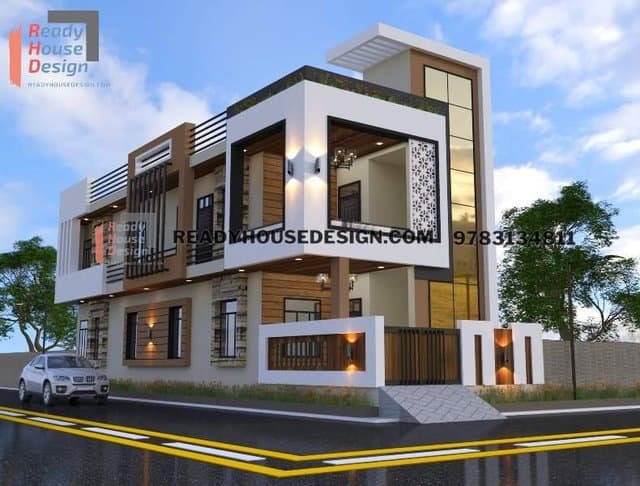stages of house construction in India
Unveiling the Stages of House Construction in India: A Comprehensive Guide
Constructing a house in India is a multi-faceted endeavour that involves careful planning, meticulous execution, and adherence to various regulatory processes. The journey from a vacant plot to a fully functional home unfolds through distinct stages, each playing a crucial role in shaping the final outcome. In this comprehensive guide, we unveil the stages of house construction in India, providing insights into the key activities and considerations at each step of the process.

Stage 1: Pre-Construction Planning
1.1 Property Selection:
The journey begins with selecting an appropriate piece of land. Consider factors such as location, accessibility, proximity to essential amenities, and soil quality.
1.2 Design and Architectural Planning:
Engage with architects and designers to create detailed plans for your home. This involves deciding on the layout, room configurations, and overall architectural style.
1.3 Regulatory Approvals:
Obtain necessary approvals from local authorities. This includes clearance for the building plan, environmental clearances, and any other permissions required for construction.
1.4 Budgeting and Financing:
Establish a comprehensive budget that covers all aspects of construction, from land acquisition to finishing touches. Secure financing through loans or other means.
Stage 2: Foundation Construction
2.1 Site Preparation:
Clear the construction site of any debris or vegetation. Excavate the soil to the required depth for the foundation.
2.2 Foundation Design:
Choose a suitable foundation type based on soil conditions and structural requirements. Common types include shallow foundations (strip or raft) and deep foundations (pile or pier).
2.3 Foundation Construction:
Pour concrete into the excavated area to create the foundation. Reinforce with steel bars for added strength. Allow time for curing before proceeding.
Stage 3: Superstructure Construction
3.1 Structural Framework:
Build the structural framework of the house using materials like concrete, steel, or brick. This includes constructing columns, beams, and slabs according to the architectural plans.
3.2 Walls and Partitions:
Erect exterior and interior walls using bricks, concrete blocks, or other suitable materials. Install partitions to define individual rooms.
3.3 Roof Construction:
Construct the roof, choosing from various designs such as flat, pitched, or sloped roofs. Roofing materials may include concrete, metal, tiles, or other options.
Stage 4: Enclosure and Exterior Finishes
4.1 Doors and Windows:
Install doors and windows to enclose the structure. Choose materials that align with the architectural style and provide security and energy efficiency.
4.2 Exterior Finishes:
Apply exterior finishes such as plaster, paint, or cladding to protect the structure from weather elements. This stage enhances the aesthetic appeal of the house.
4.3 Waterproofing and Insulation:
Ensure the building is adequately waterproofed to prevent leakage. Install insulation materials to regulate internal temperature and improve energy efficiency.
Stage 5: Interior Finishes
5.1 Flooring:
Select and install flooring materials for each room. Options include tiles, wood, laminate, or a combination of materials based on design preferences and functionality.
5.2 Wall Finishes:
Apply finishes to interior walls, including paint, wallpaper, or textured surfaces. This stage adds personality and style to the living spaces.
5.3 Ceiling Finishes:
Complete the ceilings with finishes such as paint, gypsum board, or decorative elements. Consider lighting fixtures and ventilation options during this stage.
Stage 6: Installation of Utilities
6.1 Electrical Wiring:
Install electrical wiring throughout the house, including outlets, switches, and lighting fixtures. Ensure compliance with safety standards and regulations.
6.2 Plumbing:
Set up the plumbing system, including pipes, fixtures, and fittings. Install water supply lines, drainage systems, and sewage connections.
6.3 HVAC Systems:
If applicable, install heating, ventilation, and air conditioning (HVAC) systems. This ensures climate control and comfortable living conditions.
Stage 7: Interior Furnishing and Cabinetry
7.1 Cabinetry:
Install cabinets and built-in furniture in areas such as kitchens, bathrooms, and bedrooms. This stage adds functionality and storage solutions to the living spaces.
7.2 Interior Furnishing:
Furnish the interiors with furniture, fixtures, and decorative elements. Consider factors such as comfort, aesthetics, and practicality.
7.3 Final Touches:
Add final touches such as curtains, blinds, and accessories to complete the interior design. This stage transforms the house into a personalized and inviting home.
Stage 8: Landscaping and Exterior Elements
8.1 Landscaping:
Design and implement landscaping features such as gardens, lawns, trees, and outdoor living spaces. This enhances the overall curb appeal of the property.
8.2 Exterior Lighting:
Install outdoor lighting fixtures for safety and aesthetics. Consider illuminating pathways, gardens, and architectural features.
8.3 Final Inspections:
Conduct final inspections to ensure all construction and finishing elements meet quality standards and comply with regulations.
Stage 9: Handover and Occupancy
9.1 Documentation:
Complete all legal and administrative documentation, including obtaining the occupancy certificate from local authorities.
9.2 Handover:
Receive the keys to the house from the builder or contractor. This marks the formal handover of the property to the homeowner.
9.3 Occupancy:
Move into the newly constructed house and begin enjoying the comforts of your new home.
Conclusion:
The stages of house construction in India represent a dynamic and intricate process that requires collaboration among various stakeholders, including architects, builders, and homeowners. From the initial planning phases to the final touches, each stage contributes to the creation of a safe, functional, and aesthetically pleasing home. Understanding these stages empowers homeowners.

